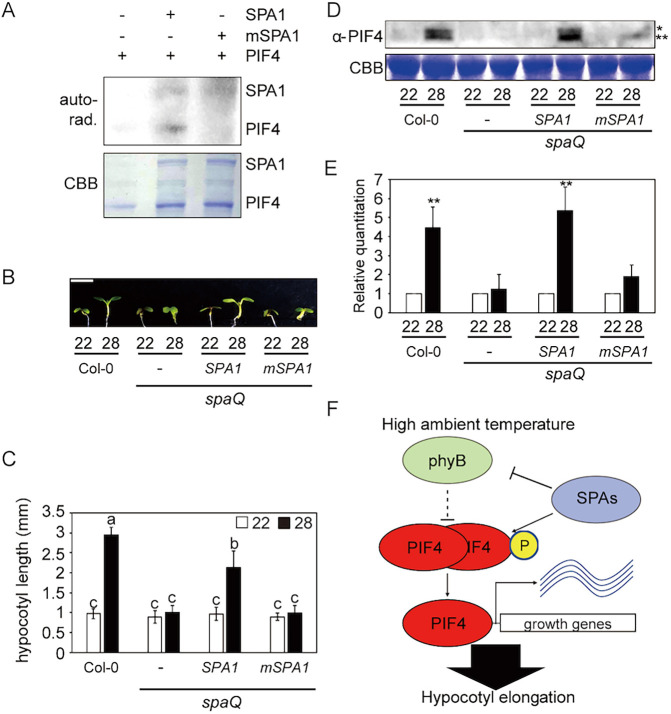Fig. 5.
Phosphorylation of PIF4 by SPA1 is essential for thermomorphogenesis. (A) The autoradiograph (top panel) shows that SPA1 directly phosphorylates PIF4, whereas mSPA1 significantly reduces PIF4 phosphorylation in vitro. In vitro kinase assay performed using purified SPA1 or mSPA1 from Pichia pastoris and GST-PIF4 from Escherichia coli. The Coomassie Blue-stained gel (bottom panel) shows the amount of protein used in the assay. (B) Photograph shows the seedling phenotypes of Col-0, spaQ, 35S:LUC-SPA1/spaQ and 35S:LUC-mSPA1/spaQ at 22 or 28°C. Three spaQ background plants are indicated with a dash for spaQ, SPA1 for 35S:LUC-SPA1/spaQ, and mSPA1 for 35S:LUC-mSPA1/spaQ, respectively. Seedlings were grown for 2 days in continuous white light at 22°C and then either kept at 22°C or transferred to 28°C for an additional 4 days before being photographed. Scale bar: 2 mm. (C) Bar graph shows the hypocotyl lengths for seedlings grown in the conditions described in B. More than 10 seedlings were measured for each experiment, and the experiment was repeated three times for one-way ANOVA with Tukey's HSD test. The letters a-c indicate statistically significant differences between means of hypocotyl lengths (P<0.05) based on one-way ANOVA with Tukey's HSD test. Error bars indicate the s.d. (n=3). (D) Western blot shows native PIF4 protein level from Col-0, spaQ, 35S:LUC-SPA1/spaQ and 35S:LUC-mSPA1/spaQ whole seedlings grown for 5 days at 22°C and then either kept at 22°C or transferred to 28°C for 4 h. PIF4 was detected using native PIF4 antibody. *Phosphorylated PIF4; **unphosphorylated PIF4. (E) Bar graph shows the relative amount of PIF4 (n=3). Student's unpaired t-test: **P<0.01. (F) Simplified model shows the role of SPA proteins in regulating thermomorphogenesis at elevated temperature. After exposure to high ambient temperature, SPAs promote the degradation of phyB, but stabilize PIF4 by direct phosphorylation and/or other unknown mechanisms. Stabilized PIF4 then promotes hypocotyl elongation through direct promoter binding to hypocotyl elongation-responsive genes.

